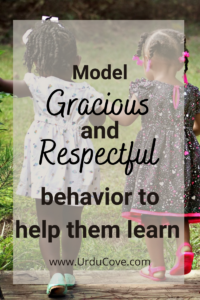Read this in:
 اردو (Urdu)
اردو (Urdu)
As first-generation immigrants, I realized we have a very different take on parenting styles. But after becoming a parent, I saw a lot of contrast between how we were brought up and how kids in the US are raised.
I recently posted about the philosophy behind Montessori education.
Listen to this post in Urdu
It helped me discover ways in which I was able to create a more nurturing environment. These Montessori tips can be applied easily in a bilingual household.
By following the Montessori tips below, I have seen my kids find themselves to be more independent and focused.

It is not easy and needs a lot of patience at times which, let’s face it, is a precious commodity nowadays. But the end result is so totally worth it!
I hope you are able to see how the following five ways can help your child as well. By no means is this an exhaustive list, but it should give you some ideas on how you could try these in your house and maybe turn your kids into perfectly well behaved, well-read, organized little people (although, that might be pushing it a bit)
So without further ado, let’s dive right in.
Respect is the name of the game
We all love our children and respect them, isn’t that the same thing? Well, honestly that is not quite true. Respecting means we need to give them the chance to say no to some things instead of forcing them to be submissive and follow what we are telling them to do.
For instance, if they are engrossed in something, I would avoid interrupting them and instead give them time to complete what they are doing.
By modeling what being respectful and gracious is, they will learn so much more than any other way.
I get how difficult it can be to resist the urge to just take over and finish everything, clean up, and put it away. But doing so shows them that you are not respecting their environment and their process of exploring it. The activity they are so involved in is helping them develop problem-solving skills, which can only happen with time.

A show that I found models a lot of basic respectful and courteous behavior is Daniel Tiger’s Neighborhood. Based on an old classic, Mister Rogers Neighborhood, it has simple and very important lessons about a sense of respect and caring for each other, that is hard to come by in other TV shows.
So you have to give respect to get respect.
Asking is often times more important than telling
When kids start talking, they ask a lot of questions. By default, a lot of us will respond with an answer. While it may seem like we are helping them, it is actually not as helpful as we might think.
Whether they are learning the shapes or colors, resist the urge to give an answer right away. Even as adults, our brains are wired to make more connections and reinforce those concepts if we ask questions versus simply providing the answers.
This is a very successful strategy that has proven benefits for learning in the long term as well.
Ask them what they know and guide them on how to think about the problem at hand.
For example, instead of saying,” speak to me in Urdu please”, you can respond as, “how would you say that in Urdu?” This will make them pause and try to recall what they already know. Repeating this will reinforce those concepts much more efficiently.
If they want to do things themselves, Let Them!
A key way in which Montessori helped me was to let go of the notion that children are helpless and we need to do everything for them. Honestly, that gets exhausting.
We are all too familiar with how, as kids, our parents liked to pamper us and did everything for us.
While it may seem like a culturally appropriate thing to do, it goes against the children’s natural drive to do things themselves and gain confidence ad independence.

As I learned about this, I thought about my daughter’s room and made some changes to help her make her own choices.
This included things like keeping outfits within her reach and creating a small vanity area with a mirror for her own grooming. There are other ways you can do that as well, as mentioned in this post. (click to learn more)
Let them choose, within limits
I know what you are thinking. If I let my kid choose an outfit, this is going to get crazy real fast.
So let me tell you the trick to doing this in a more reasonable manner.
You need to give them choices but not unlimited options.
So instead of asking them; “what do you want to wear today?” You would ask them, “do you want to wear that green outfit or this red dress today?”
While asking them open-ended questions may seem like you are helping them, young kids are not that good at coming up with good answers using their imagination at a young age. So you have to teach them by asking them focused questions.
As a result, they are free to choose from the available options.
Baby-talk should be avoided
I think we all agree that communicating clearly is a vital skill as an adult. This may be one of the most important Montessori tips.
But it is not just something that you can pick up in a short time. It is a skill that needs years of practice, even before we start school.
Talking to our children in a clear and logical way without made-up words helps them recognize what clear speech sounds like. If they are too young to reply, you are still modeling with your own speech how they should respond to you.

As a matter of fact, parents (Yes! meaning both mom and dad) have the natural mental wiring to guide their kids at just the right difficulty level by talking to them, asking them questions, and leading their thought process.
I was curious about how young I could teach my younger daughter to communicate with sign language. She was able to sign, “more milk”, “all done” and “more” when she was just 8 months old! My older daughter loved to teach her as well.
I have this link for you to learn more about teaching children sign language.
I have learned, that many tantrums can be prevented if you focus more on helping your child communicate their needs. This takes time and patience but it also helps the kids learn to express themselves in other ways.
I hope you found these Montessori tips helpful. Maybe you are already doing some of these yourself. Let me know in the comments below.

You can easily share this article with your friends by simply clicking on the button below.
Read this in:
 اردو (Urdu)
اردو (Urdu)


Love these tips. I was looking for tips on Montessori training for my 18 months old toddler and these are perfect. For my older kids (5 and 8) I love how you mentioned that instead of reminding them to speak in Urdu you ask them how to say in Urdu. We have also told our kids we do not want them to learn Urdu because Abbu and mommy use Urdu to say their secrets. If the kids learn Urdu then the parents will not be able to share secrets in front of them. So my kids are using ‘creative’ ways to learn Urdu quickly and find out all our secrets. This is exactly what Montessori style learning does. Let the kids teach themselves.
Thank you for reading and sharing that valuable feedback. It is always a good idea to let the kids use their knowledge and tell us what they know before we guide them. It sure needs a lot of practice though. Keep up the great work you are doing with your kids to teach them Urdu.